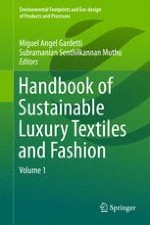2015 | Buch
Handbook of Sustainable Luxury Textiles and Fashion
Volume 1
herausgegeben von: Miguel Angel Gardetti, Subramanian Senthilkannan Muthu
Verlag: Springer Singapore
Buchreihe : Environmental Footprints and Eco-design of Products and Processes
